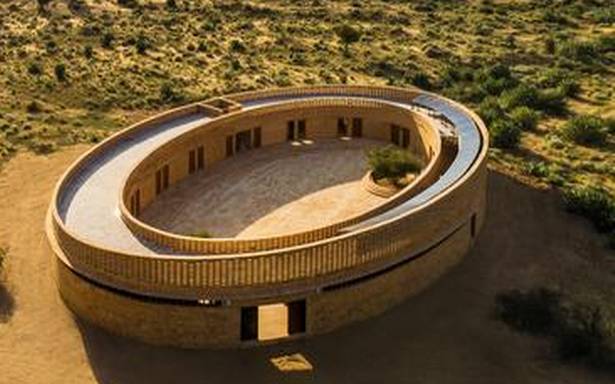How a girls’ school in Jaisalmer has brought together an architect from New York, local stoneworkers, and the opportunity for a new economic avenue
Rising out of the desert in Jaisalmer is an oval-shaped oasis. Even as sunlight filters through its jalis, it blends into the dunes surrounding it, almost as if it grew out of the shifting sands. Soon it will be ringing with the voices of 400 girls — ranging from kindergarten to class 10 — as the Rajkumari Ratnavati Girls School opens its doors.
New York-based architect Diana Kellogg
Designed by Diana Kellogg Architects, the school is funded by CITTA, an international non-profit founded by Michael Daube. As the New York-based artist, who has close ties to the ‘Golden City’ (known so because of the yellow sandstone used in its buildings), told The Guardian recently, the school is the first of a trio that will collectively become the Gyaan Centre. The other buildings will house a women’s cooperative and an exhibition-cum-performance hall, and a textile museum. “I realised that through an economic avenue, I could entice the [local] communities to send their girls to school,” he said, sharing how the centre will have craftspeople to impart skills such as weaving and printing to the students’ mothers and aunts, and a marketplace to exhibit and sells their goods.
Tales in ajrak and marble
- The school is located near the village of Kanoi, Jaisalmer, on land donated by Manvendra Singh Shekhawat, owner of the Suryagarh Palace hotel and a director for CITTA Foundation India. The project has also drawn on a host of collaborators, including designer Sabyasachi Mukherjee and architect Rooshad Shroff. Mukherjee, who is best known for his sumptuous wedding outfits, has designed the girls’ navy blue ajrak uniforms. “What I like about ajrakh is that it is visually distinct,” he says. “While it is an ancient craft, and its production is complex, its simple graphic patterns evoke a sense of modernity and timelessness.” Meanwhile, Shroff pitched in with two separate fund-raising initiatives. For 2019’s Gyaan Project, he drew on his roster of well-heeled clients for a charity auction of marble inlay plates — designed by artists and designers, including the likes of Christian Louboutin, Tanya Goel, and Manish Arora — at Isha Ambani’s seafront home. Recently, he launched the Doodle Project, through which clients can immortalise their children’s drawings as marble inlay plates. “What I wanted to create was something which would be slightly more long-term in terms of sustaining the running of the school,” he says. All the proceeds will go towards paying for the education of the girls.
Trusting the local
For Diana Kellogg, the project came at a time when, as she told Architectural Digest, she wanted her work “to affect a larger audience, to have a sense of nurturing, comfort and healing”. The architect, with over 25 years of experience, is well-known for her tasteful renovations and luxury residences in Manhattan. She has recently expanded her horizons, with work on education institutes in Nepal’s Limi Valley alongside the centre in Rajasthan. She is designing the latter pro-bono. “I’ve always been committed to issues related to women and girls, particularly in recent years,” she tells me by email from New York. “I’ve visited India over five years, and [been to] many schools. But I mostly got to know the people of Jaisalmer.” So when Daube approached her, she “wanted to use the traditional forms [of the region] in a contemporary way to show that the stone craftsmanship could be used in innovative ways.”
Using the local sandstone and recreating the curved walls of the Jaisalmer Fort, or Sone ka Quila, the scale of Kellogg’s design is sweeping: from the curved terrace and winding corridors, to the walls topped with latticed screens. “At one of the first meetings, we were discussing materials to use. Of course I wanted to use the beautiful local sandstone, but I thought it would be too expensive. However, to every suggestion of an alternate option, the response was the same… stone. ‘We can carve anything out of it,’ they said. And they did,” she states, adding how skilled local artisans made everything from individual bricks to sculptural water-cooler openings in the yellow stone. “When we couldn’t find the right sized sinks for the washrooms, they carved them out of solid stone.”
Snapshots from the school | Photo Credit: Bharath Ramarutham / AD, Condé Nast India
Plans in motion
Having never worked in a desert landscape, or with stone artisans for that matter, she had challenges a plenty. “The issues concerning climate and technique were completely different than anything I was familiar with. I knew I had to work with local building techniques and lime plaster as they have been successfully building monuments for centuries in these extreme climates,” she says, underlining their commitment to sustainability.
Phase two of the project will soon get underway. “We are planning the central building, which will be an arts centre incorporating dance and performance spaces, along with a library and computer facilities. There will also be gallery space for visiting artists. This building will mostly exhibit the textiles of the region, which we’ve been buying from the villagers to help support them during the pandemic. This way, their work will remain in Jaisalmer, for them to visit,” she concludes.
Source: Read Full Article


